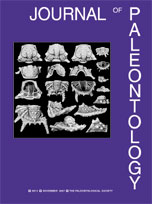A new monospecific family of asteroids (Echinodermata) is based on Eukrinaster ibexensis n. gen. and sp. from the Lower Ordovician of Utah and Nevada. Eukrinaster, Arenig in age, is one of the earliest of known asterozoans. The new, relatively well-preserved fossils yield important information on character state distribution that will be useful for the interpretation of phylogenetic relationships among the three asterozoan classes, the Somasteroidea, Ophiuroidea, and Asteroidea. In addition, overall form is suggestive of certain living asteroids: to the extent that form equates with function, similarities suggest ecologic parallels in these only distantly related asteroids inhabiting ecologically distinct worlds.
How to translate text using browser tools
1 November 2007
A NEW, PHYLOGENETICALLY SIGNIFICANT EARLY ORDOVICIAN ASTEROID (ECHINODERMATA)
DANIEL B. BLAKE,
THOMAS E. GUENSBURG,
JAMES SPRINKLE,
COLIN SUMRALL
ACCESS THE FULL ARTICLE

Journal of Paleontology
Vol. 81 • No. 6
November 2007
Vol. 81 • No. 6
November 2007




